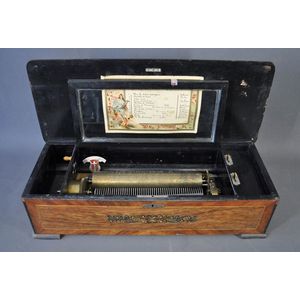Swiss Music Box with Eight Airs
You must be a subscriber, and be logged in to view price and dealer details.
Subscribe Now to view actual auction price for this item
When you subscribe, you have the option of setting the currency in which to display prices to $Au, $US, $NZ or Stg.
- Rosewood - A dense timber that varies in shade to very light brown to almost black. When rosewood is cut and sanded the colour of the timber will turn black, and after polishing and exposure to daylight, the surface will gradually lighten over time to light brown with black streaks.
The name comes from the odour emanating from the timber when it is planed, sanded or cut.
Rosewood was very popular for use in Victorian furniture in the second half of the 19th century, and at that time most of the rosewood was imported from Brazil. However it also grows in India and Indonesia.
It is used in the sold for chairs and table legs, but for carcase furniture such as side cabinets and bookcases, and for table tops it is always used as a veneer. - Satinwood - Satinwood is a dense pale gold coloured timber that was imported into Britain in the second half of the 18th century, and early 19th centuries from the East Indies and the West Indies. The name derives from the satin-like surface sheen when the timber is polished.
It was used in the solid, as a veneer and in inlays. As well as furniture, satinwood was used for making musical instruments, barometers, boxes and clocks.
It will usually be found on only the very best quality objects, presumably because of of its cost at the time. - Ebony - Ebony is a close grained timber, black in colour. It has a fine texture which can be polished to a high gloss, making it suitable for venereering, inlay and stringing and its use as solid timber is resticted to small decorative items and ornamental decoration, such as chess pieces and musical instrument parts. The term "ebonised" means "faux ebony", timber that has been darkened during the polishing process to resemble ebony.
This item has been included into following indexes:
Visually similar items

Swiss music box. Walnut veneer case with 12 airs movement. Tune indicator. Working order, requires restoration. Height 15 cm. Width 59 cm. Diameter 24 cm

An antique music box, early 20th century, with stamp for L J Williams specialist in antique clocks and music boxes, Sydney, number 4564, in a rosewood case with cross banding and marquetry embellishment to the lid featuring musical instruments and sheet mu

Swiss 12 Air music box. Inlaid walnut case containing 16 1/2inch cylinder 12 air movement. Two springs & low note damper. Functional. Estate late Douglas Osborne Hawke. W76 cm

A lever wind music box, 19th century, string and panel inlay to lid, sides and front. 28 cm long cylinder x 5.5 cm diameter. Eight tunes with tune sheet, 20 cm high, 60 cm wide, 27 cm deep
